Two-Step Multi-Objective Reliability-Based Design Optimization of Aircraft Wing Structures
Abstract
:1. Introduction
2. A Two-Step Multi-Objective Reliability-Based Design Using Fuzzy Set Model
2.1. Possibility Safety Index
2.2. Two-Step Approach
- To perform the multi-objective optimization run to find the solution set.
- To perform the multi-objective reliability-based analysis to find the solution set using the solution set from step 1.
- The new technique solution is a solution set with various PSI values derived from a single optimization run, which saves time. A designer can use it for an aircraft wing structure design with a different PSI value or an equivalent of probability failure.
- It is simple to handle and apply to the real optimization problem, which is a MODO problem.
- The present technique is simple to combine with a high-performance MOEA.
2.3. ARPBIL-DE Optimizer
3. Numerical Experiment
4. Results and Discussions
5. Conclusions
Author Contributions
Funding
Institutional Review Board Statement
Informed Consent Statement
Data Availability Statement
Acknowledgments
Conflicts of Interest
References
- Sleesongsom, S.; Yooyen, S.; Prapamonthon, P.; Bureerat, S. Reliability-based design optimization of classical wing aeroelasticity. IOP Conf. Ser. Mater. Sci. Eng. 2020, 886, 012015. [Google Scholar] [CrossRef]
- Elishakoff, I.; Colombi, P. Combination of probabilistic and convex models of uncertainty when scare knowledge is present on acoustic excitation parameters. Comput. Methods Appl. Mech. Eng. 1993, 104, 187–209. [Google Scholar] [CrossRef]
- Fang, J.; Smith, S.M.; Elishakoffk, I. Combination of anti-optimization and fuzzy-set-based analyses for structural optimization under uncertainty. Math. Probl. Eng. 1998, 4, 187–200. [Google Scholar] [CrossRef] [Green Version]
- Moller, B.; Graf, W.; Beer, M. Fuzzy structural analysis using α-level optimization. Comput. Mech. 2000, 26, 547–565. [Google Scholar] [CrossRef]
- Tang, Z.C.; Lu, Z.Z.; Hu, J.X. An efficient approach for design optimization of structures involving fuzzy variables. Fuzzy Set. Syst. 2014, 255, 52–73. [Google Scholar] [CrossRef]
- Wang, L.; Lui, G.; Qiu, Z. Review: Recent developments in the uncertainty-based aero-structural design optimization for aerospace vehicles. J. Harbin. Inst. Technol. 2018, 25, 1–15. [Google Scholar]
- Manan, A.; Cooper, J. Design of composite wings including uncertainties: A probabilistic approach. J. Aircr. 2009, 46, 601–607. [Google Scholar] [CrossRef]
- Scarth, C.; Cooper, J.E.; Weaver, P.M.; Silva, G.H.C. Uncertainty quantification of aeroelastic stability of composite plate wings using lamination parameters. Comput. Struct. 2014, 116, 84–93. [Google Scholar] [CrossRef]
- Cook, R.G.; Wales, C.; Gaitonde, A.; Jones, D.; Cooper, J.E.; Tartinville, B.; van der Ven, D. Uncertainty quantification of aeroelastic systems with structural or aerodynamic nonlinearities. In Proceedings of the Applied Aerodynamics Conference, Atlanta, Georgia, 25–29 June 2018; American Institute of Aeronautics and Astronautics: Reston, VA, USA, 2018. [Google Scholar]
- Wansaseub, K.; Sleesongsom, S.; Panagant, N.; Pholdee, N.; Bureerat, S. Surrogate-assisted reliability optimisation of an aircraft wing with static and dynamic aeroelastic constraints. Int. J. Aeronaut. Space Sci. 2020, 21, 723–732. [Google Scholar] [CrossRef]
- Yin, H.; Yu, D.; Xia, R. Reliability-based topology optimization for structures using fuzzy set model. Comput. Methods Appl. Mech. Eng. 2018, 333, 197–217. [Google Scholar] [CrossRef]
- Sleesongsom, S.; Bureerat, S. Multi-objective reliability-based topology optimization of structures using a fuzzy set model. J. Mech. Sci. Technol. 2020, 34, 3973–3980. [Google Scholar] [CrossRef]
- Sleesongsom, S.; Bureerat, S. Multi-objective, reliability-based design optimization of a steering linkage. Appl. Sci. 2020, 10, 5748. [Google Scholar] [CrossRef]
- Scarth, C.; Cooper, J.E. Reliability-based aeroelastic design of composite plate wings using a stability margin. Struct. Multi. Discip. Optim. 2018, 57, 1695–1709. [Google Scholar] [CrossRef] [Green Version]
- Yu, Y.; Wang, Z.; Guo, S. Efficient method for aeroelastic tailoring of composite wing to minimize gust response. J. Aerosp. Eng. 2017, 1592527. [Google Scholar] [CrossRef] [Green Version]
- Muneer, A.; Taib, S.M.; Naseer, S.; Ali, R.F.; Aziz, I.A. Data-driven deep learning-based attention mechanism for remaining useful life prediction: Case study application to turbofan engine analysis. Electronics 2021, 10, 2453. [Google Scholar] [CrossRef]
- Luo, X.; Grandhi, R.V. Astros for reliability-based multidisciplinary structural analysis and optimization. Comput. Struct. 1997, 62, 737–745. [Google Scholar] [CrossRef]
- Amrit, A.; Leifsson, L.; Koziel, S. Fast multi-objective aerodynamic optimization using sequential domain patching and multifidelity models. J. Aircr. 2020, 57, 388–398. [Google Scholar] [CrossRef]
- Pietrenko-Dabrowska, A.; Koziel, S. Accelerated multiobjective design of miniaturized microwave components by means of nested kriging surrogates. Int. J. RF Microw. Comput. Aided Eng. 2020, 30, e22124. [Google Scholar] [CrossRef]
- Koziel, S.; Pietrenko-Dabrowska, A. Rapid multi-objective optimization of antennas using nested kriging surrogates and single-fidelity EM simulation models. Eng. Comput. Int. J. Comput. Aided Eng. 2019, 37, 1491–1512. [Google Scholar] [CrossRef]
- Koziel, S.; PietrenkoDabrowska, A. Fast multi-objective optimization of antenna structures by means of data-driven surrogates and dimensionality reduction. IEEE Access 2020, 8, 183300–183311. [Google Scholar] [CrossRef]
- Koziel, S.; Pietrenko-Dabrowska, A. Constrained multi-objective optimization of compact microwave circuits by design triangulation and pareto front interpolation. Eur. J. Oper. Res. 2022, 299, 302–312. [Google Scholar] [CrossRef]
- Koziel, S.; Pietrenko-Dabrowska, A.; Ullah, U. Tolerance-aware optimization of microwave circuits by means of principal directions and domain-restricted metamodels. IEEE Trans. Microw. Theory Techn. 2022, 70, 4085–4093. [Google Scholar] [CrossRef]
- Koziel, S.; Pietrenko-Dabrowska, A. Tolerance optimization of antenna structures by means of response feature surrogates. IEEE Trans. Ant. Prop. 2022. [Google Scholar] [CrossRef]
- Koziel, S.; Pietrenko-Dabrowska, A. Tolerance-aware multi-objective optimization of antennas by means of feature-based regression surrogates. IEEE Trans. Ant. Prop. 2022, 70, 5636–5646. [Google Scholar] [CrossRef]
- Lee, J.O.; Yang, Y.S.; Ruy, W.S. A comparative study on reliability-index and target-performance based probabilistic structural design optimization. Comput. Struct. 2002, 80, 257–269. [Google Scholar] [CrossRef]
- Shayanfar, M.; Abbasnia, R.; Khodam, A. Development of a GA-based method for reliability-based optimization of structures with discrete and continuous design variables using Open Sees and Tcl. Finite. Elem. Anal. Des. 2014, 90, 61–73. [Google Scholar] [CrossRef]
- Safaeian Hamzehkolaei, N.; Miri, M.; Rashki, M. An enhanced simulation-based design method coupled with meta-heuristic search algorithm for accurate reliability-based design optimization. Eng. Comput. 2016, 32, 477–495. [Google Scholar] [CrossRef]
- Ho-Huu, V.; Vo-Duy, T.; Nguyen-Thoi, T.; Ho-Nhat, L. Optimization of truss structures with reliability-based frequency constraints under uncertainties of loadings and material properties. In Proceedings of the 1st International Conference on Applied Mathematics in Engineering and Reliability, Ho Chi Minh City, Vietnam, 4–6 May 2016; CRC Press: Boca Raton, FL, USA; pp. 59–65. [Google Scholar]
- Ho-Huu, V.; Le-Duc, T.; Le-Anh, L.; Vo-Duy, T.; Nguyen-Thoi, T. A global single-loop deterministic approach for reliability-based design optimization of structures with continuous and discrete design variables. Eng. Optim. 2018, 50, 2071–2090. [Google Scholar] [CrossRef]
- Dizangian, B.; Ghasemi, M.R. An efficient method for reliable optimum design of trusses. Steel Compos. Struct. 2016, 21, 1069–1084. [Google Scholar] [CrossRef]
- Ho-Huu, V.; Duong-Gia, D.; Vo-Duy, T.; Le-Duc, T.; Nguyen-Thoi, T. An efficient combination of multi-objective evolutionary optimization and reliability analysis for reliability-based design optimization of truss structures. Expert Syst. Appl. 2018, 102, 262–272. [Google Scholar] [CrossRef]
- Winyangkul, S.; Sleesongsom, S.; Bureerat, S. Reliability-based design of an aircraft wing using a fuzzy-based metaheuristic. Appl. Sci. 2021, 11, 6463. [Google Scholar] [CrossRef]
- Sleesongsom, S.; Winyangkul, S.; Bureerat, S. Multiobjective reliability-based design of an aircraft wing using a fuzzy-based metaheuristic. In Proceedings of the ASME 2021 International Mechanical Engineering Congress and Exposition, Volume 13: Safety Engineering, Risk, and Reliability Analysis, Research Posters, Virtual, 1–5 November 2021; V013T14A016. ASME: New York, NY, USA, 2021. [Google Scholar]
- Goland, M. The flutter of a uniform cantilever wing. J. Appl. Mech. 1945, 12, A197–A208. [Google Scholar] [CrossRef]
- Sleesongsom, S.; Bureerat, S.; Tai, K. Aircraft morphing wing design by using partial topology optimization. Struct. Multidiscip. Optim. 2013, 48, 1109–1128. [Google Scholar] [CrossRef]
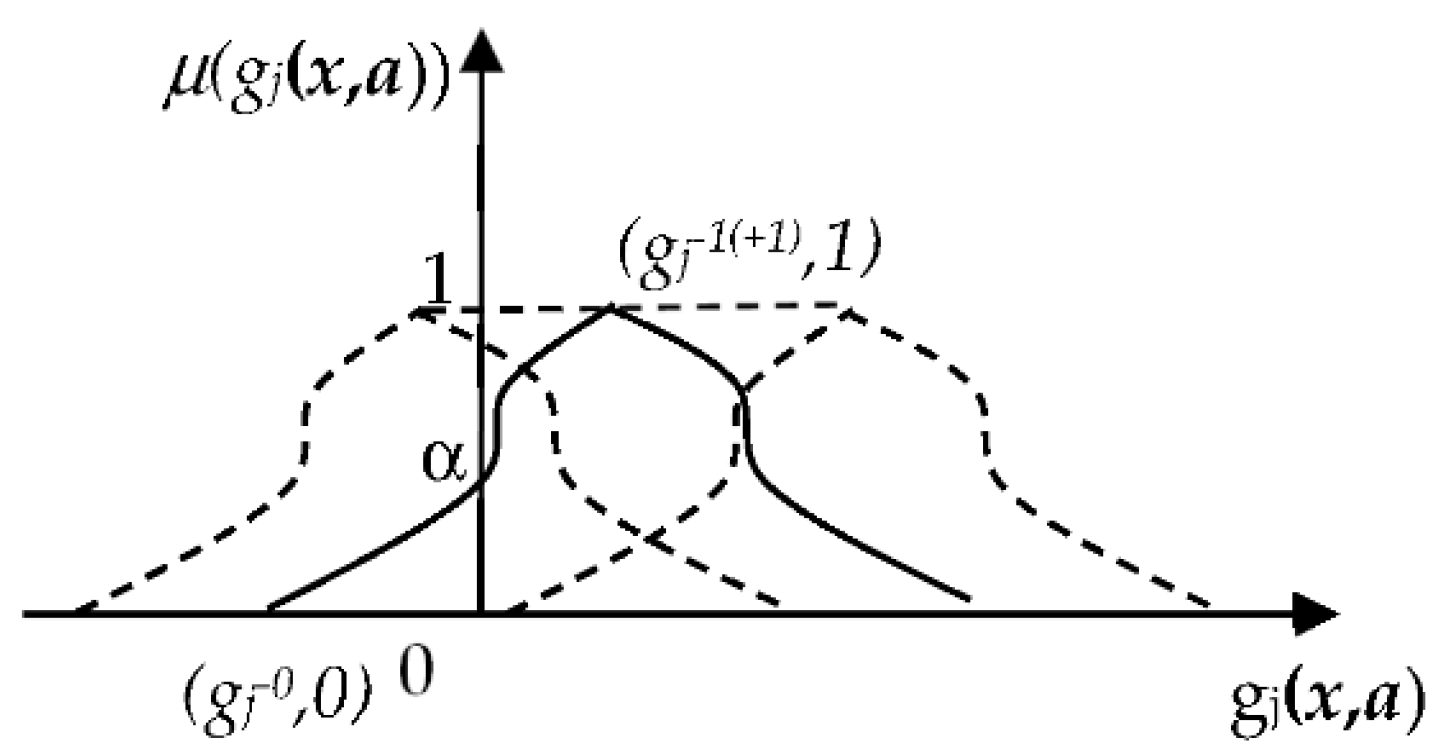
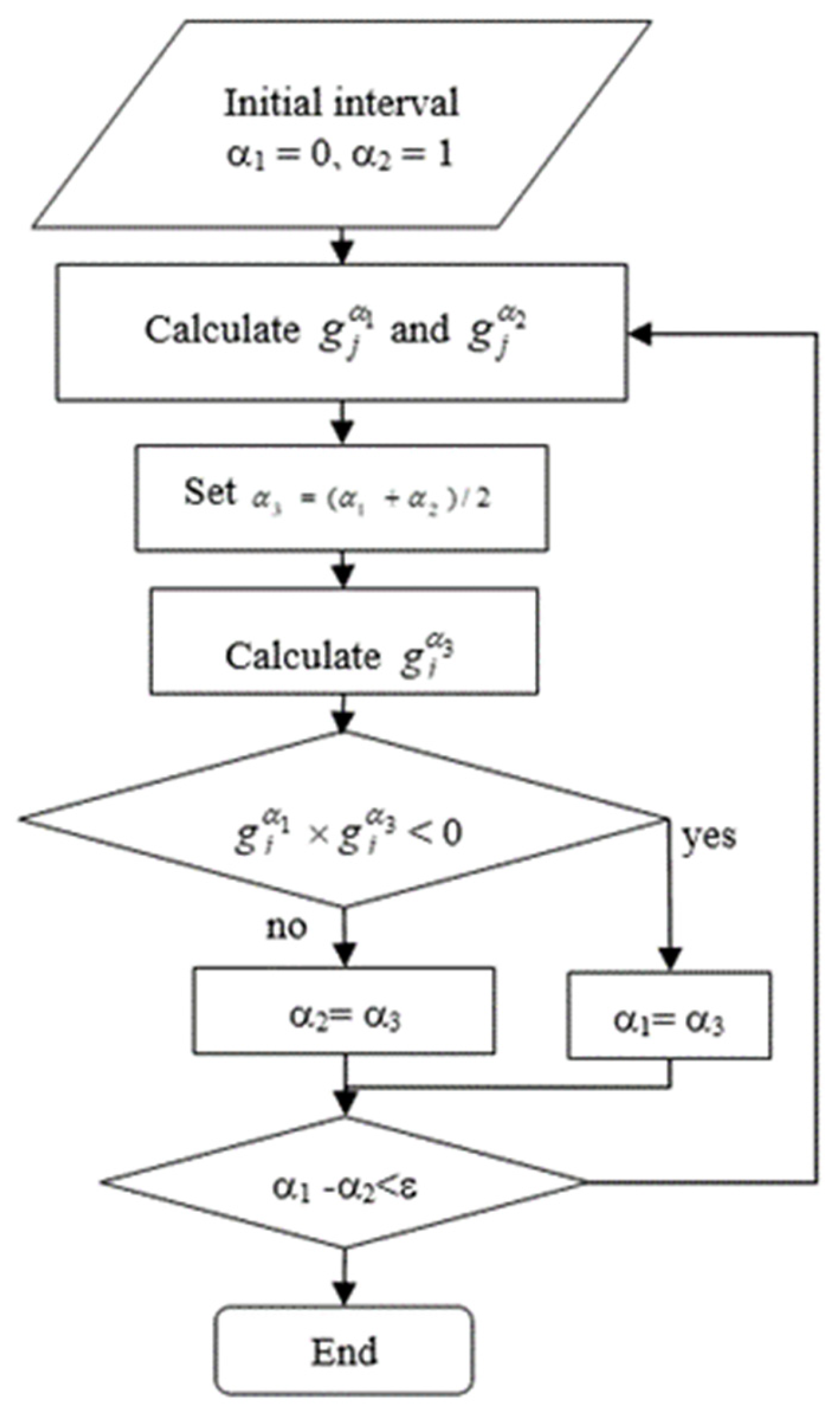
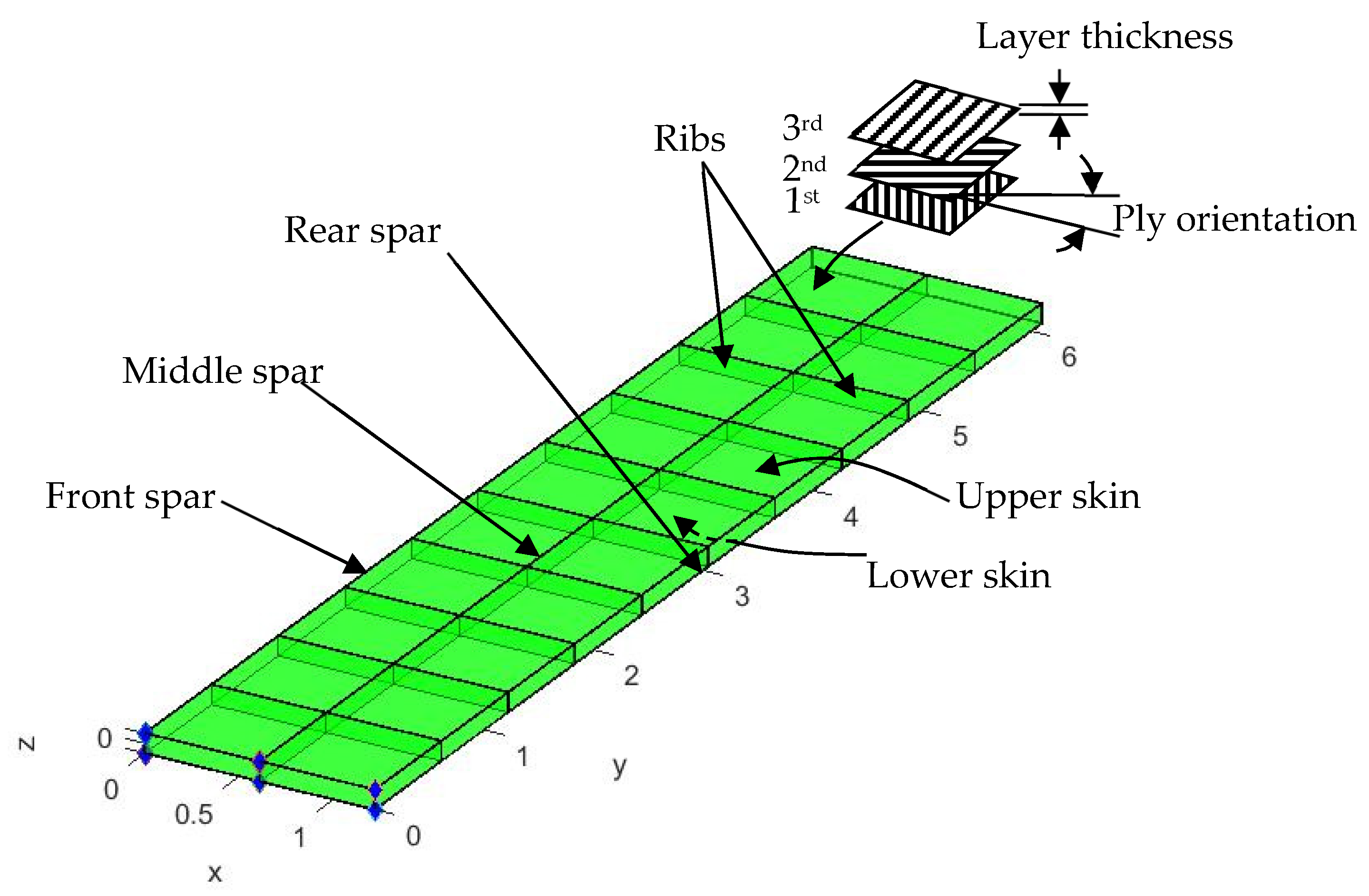
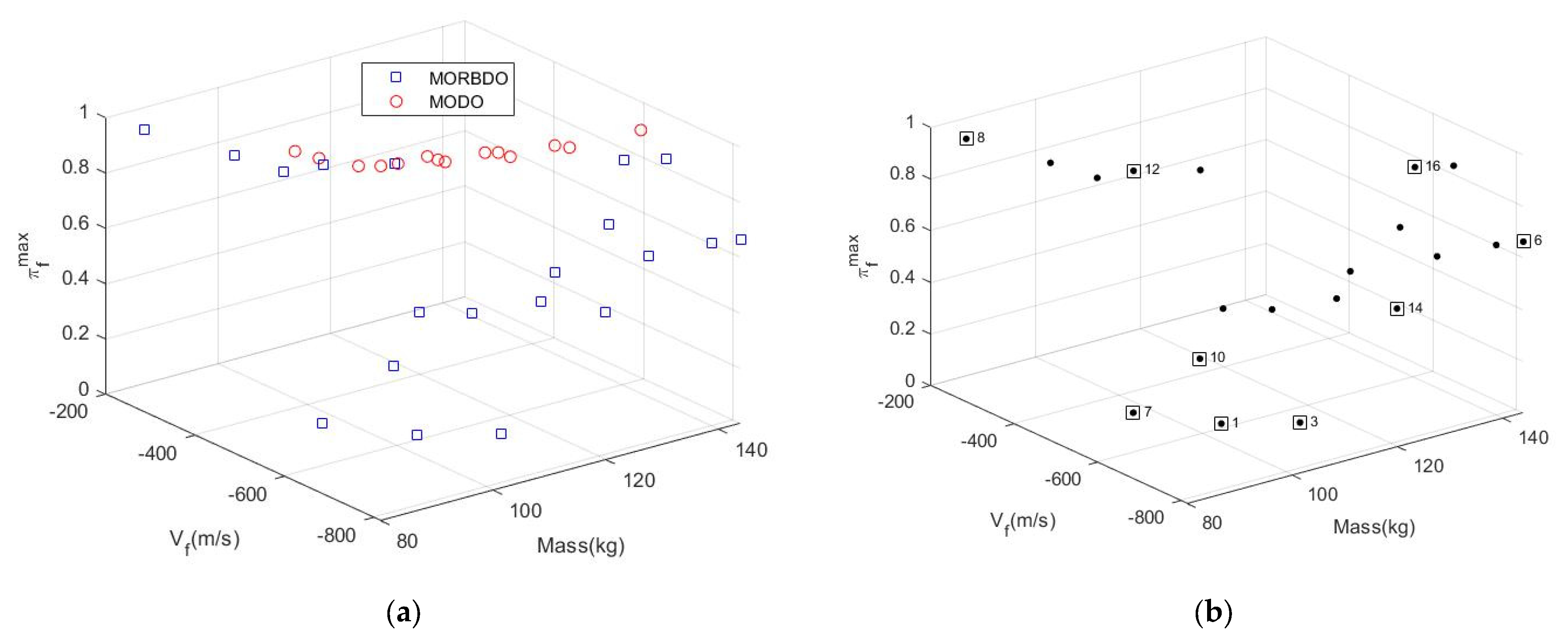
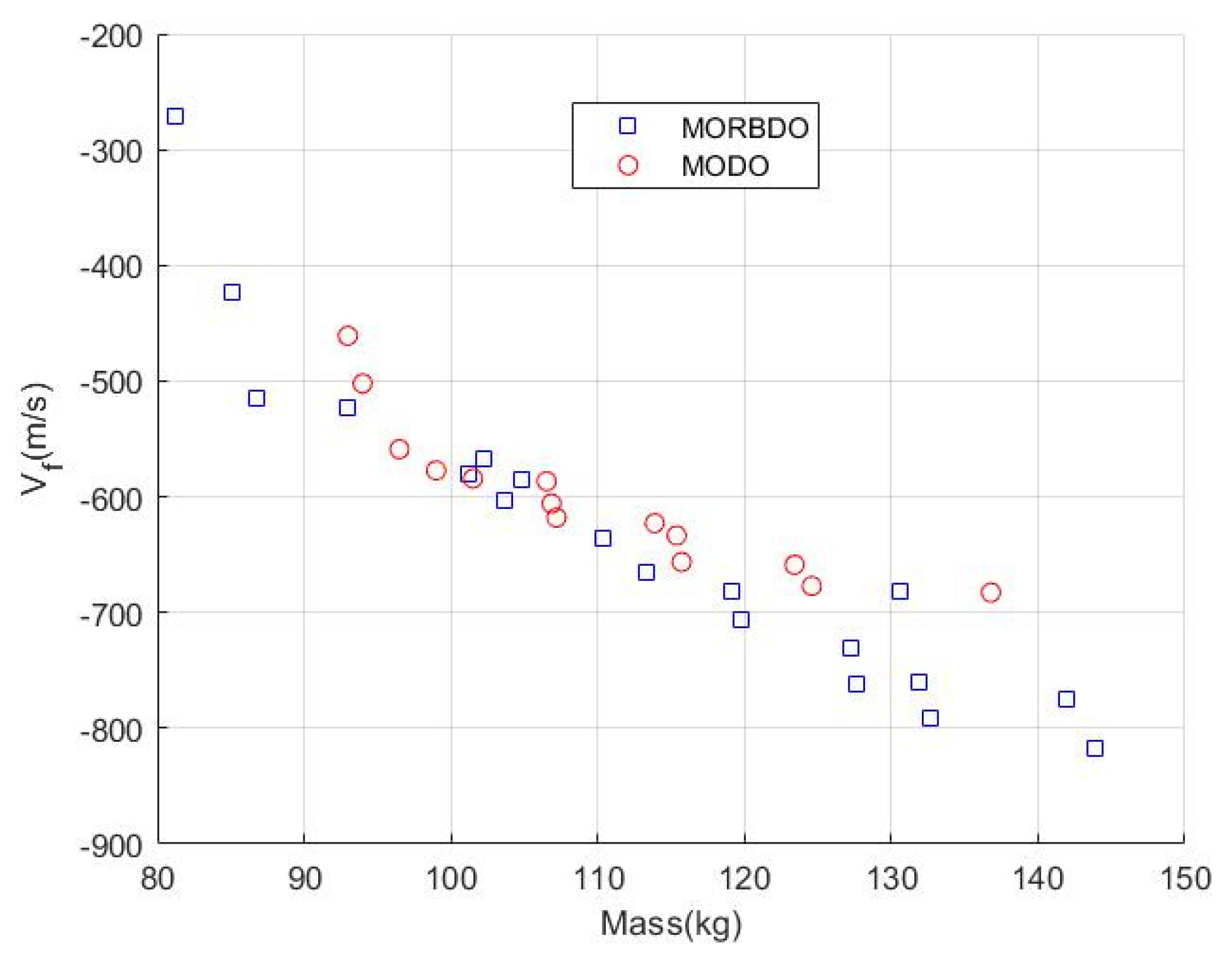


| Aluminum | ||
| Properties | Value | Unit |
| Young’s modulus (E) | 70 × 109 | Pa |
| Poisson’s ratio (ν) | 0.3 | - |
| Density (ρ) | 2700 | kg/m3 |
| Carbon Fiber | ||
| Young’s modulus (E11) | 207.7 × 109 | Pa |
| Young’s modulus (E22) | 7.6 × 109 | Pa |
| Shear modulus (G12) | 5.0 × 109 | Pa |
| Shear modulus (G13) | 5.0 × 109 | Pa |
| Shear modulus (G23) | 5.0 × 109 | Pa |
| Poisson’s ratio (ν12) | 0.3 | - |
| Density (ρ) | 1800 | kg/m3 |
| Solution Number | πfmax | Mass (kg) | Vf(m/s), η, umax(m) |
|---|---|---|---|
| 1 | 0.0011 | 104.8504 | 584.5670, 0.9872, 0.0976 |
| 3 | 0.0187 | 113.3789 | 665.5911, 0.9898, 0.0953 |
| 6 | 0.6634 | 143.8139 | 817.1501, 0.9838, 0.0554 |
| 7 | 0.0634 | 92.9774 | 523.1548, 1.0444, 0.0994 |
| 8 | 1 | 81.2716 | 270.4468, 1.0471, 0.1450 |
| 10 | 0.2543 | 102.1748 | 566.7761, 1.0088, 0.0905 |
| 12 | 1 | 92.9774 | 523.7595, 1.0277, 0.0915 |
| 14 | 0.3763 | 130.6031 | 680.9572, 1.0142, 0.0761 |
| 17 | 1 | 86.7900 | 514.7193, 1.1278, 0.1428 |
| Solution Number | PSI | R |
|---|---|---|
| 1 | 0.001 | 0.3566 |
| 7 | 0.0634 | 0.3299 |
| 14 | 0.3763 | 0.0961 |
| 6 | 0.6634 | 0.0140 |
| Design Variables and Objective Function | πfmax = 0.6634 (sol.6) | πfmax = 0.3763 (sol.14) | πfmax = 0.0011 (sol.1) | Deterministic (sol.8) |
|---|---|---|---|---|
| Upper skin layer 1 (mm.) | 0.0005 | 0.0005 | 0.0005 | 0.0005 |
| Upper skin layer 2 (mm.) | 0.0040 | 0.0045 | 0.0035 | 0.0020 |
| Upper skin layer 3 (mm.) | 0.0015 | 0.0015 | 0.001 | 0.001 |
| Lower skin layer 1 (mm.) | 0.0005 | 0.0005 | 0.0005 | 0.0005 |
| Lower skin layer 2 (mm.) | 0.0005 | 0.0005 | 0.0005 | 0.0005 |
| Lower skin layer 3 (mm.) | 0.0005 | 0.0005 | 0.0005 | 0.0005 |
| Rib thickness (mm.) | 0.0050 | 0.0025 | 0.001 | 0.0025 |
| Spar thickness (mm.) | 0.0050 | 0.0030 | 0.0035 | 0.0005 |
| Lower skin layer 1 (deg.) | 75 | 105 | 105 | 120 |
| Lower skin layer 2 (deg.) | 90 | 120 | 90 | 60 |
| Lower skin layer 3 (deg.) | 0 | 0 | 0 | 0 |
| Upper skin layer 1 (deg.) | 165 | 150 | 120 | 120 |
| Upper skin layer 2 (deg.) | 105 | 105 | 30 | 15 |
| Upper skin layer 3 (deg.) | 30 | 30 | 0 | 0 |
| Techniques | Advantages | Disadvantages |
|---|---|---|
| Fuzzy |
|
|
| MCS |
|
|
| MPP |
|
|
Publisher’s Note: MDPI stays neutral with regard to jurisdictional claims in published maps and institutional affiliations. |
© 2022 by the authors. Licensee MDPI, Basel, Switzerland. This article is an open access article distributed under the terms and conditions of the Creative Commons Attribution (CC BY) license (https://creativecommons.org/licenses/by/4.0/).
Share and Cite
Sleesongsom, S.; Kumar, S.; Bureerat, S. Two-Step Multi-Objective Reliability-Based Design Optimization of Aircraft Wing Structures. Symmetry 2022, 14, 2125. https://doi.org/10.3390/sym14102125
Sleesongsom S, Kumar S, Bureerat S. Two-Step Multi-Objective Reliability-Based Design Optimization of Aircraft Wing Structures. Symmetry. 2022; 14(10):2125. https://doi.org/10.3390/sym14102125
Chicago/Turabian StyleSleesongsom, Suwin, Sumit Kumar, and Sujin Bureerat. 2022. "Two-Step Multi-Objective Reliability-Based Design Optimization of Aircraft Wing Structures" Symmetry 14, no. 10: 2125. https://doi.org/10.3390/sym14102125









